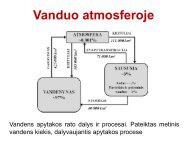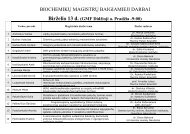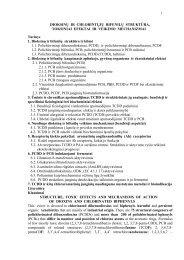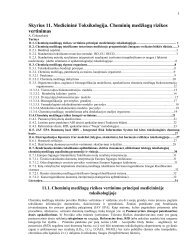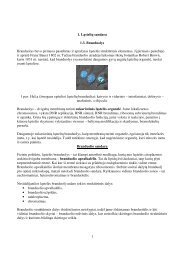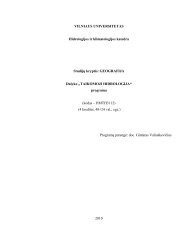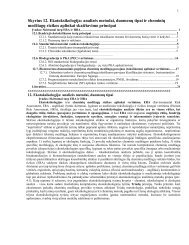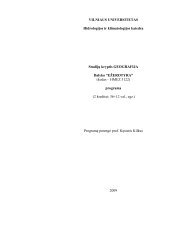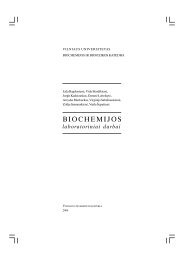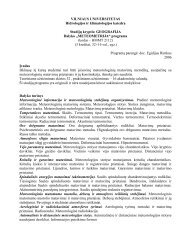Species and Their Formation - Laboratory of Visual Systems
Species and Their Formation - Laboratory of Visual Systems
Species and Their Formation - Laboratory of Visual Systems
Create successful ePaper yourself
Turn your PDF publications into a flip-book with our unique Google optimized e-Paper software.
(a)SPECIES AND THEIR FORMATION 483(b)Agelaius phoeniceus (male, NY) Agelaius phoeniceus (male, CA) Agelaius phoeniceus (female)24.2 Members <strong>of</strong> the Same <strong>Species</strong> Look Alike—or Not (a) Both<strong>of</strong> these male red-winged blackbirds are obviously members <strong>of</strong> thesame species, even though one is from the eastern United States <strong>and</strong>the other is from California. (b) Because red-winged blackbirds aresexually dimorphic (see Chapter 23), the female <strong>of</strong> the speciesappears quite different from the male.productively incompatible. Alternatively, they may becomereproductively incompatible before they evolve any noticeablemorphological differences. But how do these differencesbetween populations come about?How Do New <strong>Species</strong> Arise?Speciation is the process by which one species splitsinto two or more daughter species, which thereafter evolveas distinct lineages. Although Charles Darwin titled his bookThe Origin <strong>of</strong> <strong>Species</strong>, he did not extensively discuss speciation,a process he called “the mystery <strong>of</strong> mysteries.” He devotedmost <strong>of</strong> his attention to demonstrating that species areIncreasingGenetic distanceIncreasing01 A barrier isestablished.Interbreedingpopulation(parent species)2 The two populationsdiverge genetically butare still reproductivelycompatible.TimeDaughterspecies AReproductiveincompatibilityis established.Daughterspecies B24.3 Speciation May Be a Gradual Process In this hypotheticalexample, genetic divergence between two separated populationsbegins before reproductive incompatibility evolves.3altered by natural selection over time. But not all evolutionarychanges result in new species: A single lineage maychange over time without giving rise to a new species.The critical event in speciation is the separation <strong>of</strong> the genepool <strong>of</strong> the ancestral species into two or more separate <strong>and</strong>isolated gene pools. Subsequently, within each isolated genepool, allele <strong>and</strong> genotype frequencies may change as a result<strong>of</strong> the action <strong>of</strong> evolutionary agents. If two populations areisolated from each other, <strong>and</strong> sufficient differences in theirgenetic structure accumulate during the period <strong>of</strong> isolation,then the two populations may not be able to exchange geneswhen they come together again. As we will see, the amount<strong>of</strong> genetic difference that is needed to prevent gene exchangeis highly variable. Gene flow among populations may be interruptedin two major ways, each <strong>of</strong> which characterizes amode <strong>of</strong> speciation.Allopatric speciation requires total genetic isolationSpeciation that results when a population is divided by aphysical barrier is known as allopatric (allo-, “different”; patris,“country”) or geographic speciation (Figure 24.4). Allopatricspeciation is thought to be the dominant mode <strong>of</strong>speciation among most groups <strong>of</strong> organisms. The physicalbarrier that divides the range <strong>of</strong> a species may be a waterbody for terrestrial organisms, dry l<strong>and</strong> for aquatic organisms,or a mountain range. Barriers can form when continentsdrift, sea levels rise, glaciers advance <strong>and</strong> retreat, <strong>and</strong>climates change. These processes continue to generate physicalbarriers today. The populations separated by such barriersare <strong>of</strong>ten large initially. They evolve differences for a variety<strong>of</strong> reasons, especially because the environments inwhich they live are, or become, different.Allopatric speciation may also result when some members<strong>of</strong> a population cross an existing barrier <strong>and</strong> found a new, isolatedpopulation. Populations established in this way usuallydiffer genetically from their parent populations because <strong>of</strong>the founder effect: A small group <strong>of</strong> founding individuals has



